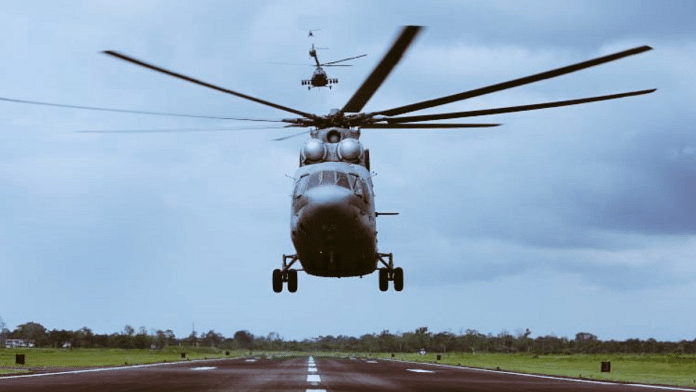New Delhi: After being grounded for several years, the Indian Air Force (IAF) fleet of Mi-26 heavy lift helicopters are finally getting overhauled following a contract signed with the Russian Helicopters, ThePrint has learnt.
Work is set to begin soon, and India will become the first country to have a simultaneous inventory of both Mi-26s and the American Chinooks.
While initially, the overhaul of three Mi-26s, which are much larger in capabilities compared to the Chinooks, was to be done in Russia, they will now be done locally with help from the Russian defence firm.
Sources in the defence and security establishment told ThePrint that the entire repair and overhaul process will require 30 months from the date of commencement of the overhaul.
The planned overhaul will extend the life of these helicopters by more than a decade, it is learnt.
Coupled with the Chinooks, the revival of these helicopters will give a boost to the air force’s heavy-lift capabilities.
It was between 1986 and 1989 that the IAF inducted four Mi-26 helicopters, of which one crashed in 2010 at the Jammu airport.
Currently, the IAF has three Mi-26 helicopters but all of them are grounded. While two Mi-26 were grounded in September 2013 and August 2014, the third became non-operational in 2017.
The Chandigarh-based No.126 Helicopter Flight (Featherweights) squadron is equipped with the Mi-26 helicopters. The squadron also operates the Chinooks.
Powered by twin turboshaft engines, the Mi-26 helicopter weighs around 28,200 kg. It has a maximum take-off weight of 56,000 kg and has the capability to even airlift a Chinook helicopter.
A source in the air force said that the Mi-26 helicopter possesses unique heavy-lift capability which was utilised by the IAF over three decades.
The overhaul process will involve firming up the airframe’s integrity and fatigue if needed, particularly the load bearing areas, and involve replacing the major components that have completed their lives.
Further, the helicopter engines will be overhauled to give them a fresh lease of life and parts like the turbine blades or the seals replaced with fresh ones. The avionics components will also be checked to see if any part needs to be replaced and indigenous systems will be integrated, the source said.
“These helicopters are very capable in terms of both internal and external load carrying capability and thus serves a critical role in airlift of heavier and voluminous loads. The Mi-26 can airlift a maximum of 20 tonnes of load and around 8-10 tonnes at high-altitudes, depending on the prevailing conditions,” one of the sources said.
While the Mi-26 offers maximum seating capacity for 82 combat-ready soldiers with maximum capacity of 20 tonnes, the Chinooks have 11 tonnes of capacity and seating for 45 soldiers.
The air force requires load to be carried without dismantling it during critical missions, the source explained.
The platform’s heavy-lift capabilities were tested during the airlift of odd-sized and heavy equipment for the Katra-Quazigund railway project as part of extending rail connectivity in the Srinagar Valley around 2010.
Furthermore, it was also extensively utilised for airlift during Operation Rahat in 2013, the sources said, adding that one of the duties the helicopter performed was the airlift of 9,000 litres of aviation turbine fuel (ATF) to Pithoragarh Advanced Landing Ground (ALG) to keep the Humanitarian Assistance and Disaster Relief (HADR) going.
The source explained that an important HADR aspect of the Mi-26’s operational capability pertains to its ability in evacuating 60 casualties along with medical attendants. “This could prove extremely useful in case of a mass casualty evacuation,” the source said.
Also Read: Replacing ageing Cheetah/Chetak choppers to take at least 10 yrs, hopes pinned on LUH & leasing
The past glory
Wing Commander Bhupinder S. Nijjar (retd.), who flew the Mi-26 helicopter from 2005 to 2010, told ThePrint, “In helicopter operations, what is most important is its key characteristic of landing and taking off vertically. This means that a helicopter can deliver the payload to otherwise inaccessible places.
“The Mi-26 helicopter has unique capabilities because it’s the only helicopter in the world that can carry up to 20 tonnes of odd-sized load at sea level. And it can do that internally as well as externally in an underslung mode.”
The terrain conditions and elevation adversely impact the load-carrying capability of a helicopter, he said, adding that the Mi-26 has proven its worth under most adverse operating conditions.
For example, at Daulat Beg Oldi (DBO), which lies at the northern edge of Depsang Plains at an elevation of 5,100 m (16,700 ft), it can carry over 5,000 kg of load, he added.
“Most other helicopters in the IAF inventory can carry a minuscule payload at this elevation. This uniqueness of the Mi-26 helicopter makes it a true force multiplier,” he said.
(Edited by Tony Rai)
Also Read: Army, air force move proposal to acquire 156 more Prachand choppers to deploy along China borders



